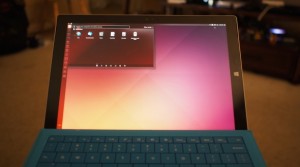Naturally, the first few comments we saw when Microsoft announced their latest incredibly powerful and fantastically thin tablet PC was some variant of “It’s a shame it is running Windows”. We decided to fix that, and here’s what came out of that experiment.
There’s not a lot to dislike about the hardware that makes up the Surface Pro 3. Even though we’re only tooling around with the Core i5 version, this machine has already proven itself to strike an admirable balance between performance, style, and portability. The operating system, on the other hand, is simply not everyone’s cup of tea. Windows 8.1 is a confusing combination of old school desktop UI with a tablet UI that isn’t yet complete enough to stand on its own.
Theoretically the Surface Pro 3 is the ideal tool with which to use Windows 8.1, but it’s still not the best OS for everyone. Luckily, the Linux community has no shortage of replacements if all you want is a touch-friendly laptop. With that in mind, we gave Ubuntu 14.04 a shot to see what the grass looked like on the other side.
The very first thing you need to do if you decide to go this route is grab a system image backup of the Surface Pro 3. This isn’t complicated, but it can take up a ton of space depending on what you currently have installed on your system. The backup image for our tests was nearly 30GB, though the backup image process itself is quite fast.
You will also need a separate drive with Windows 8.1 onboard to restore the image, since the repair and restore function will be gone if you decide to install Linux on your machine. As long as you have these two things, you can restore your Surface Pro 3 back from just about anything.
The install process for Ubuntu couldn’t be simpler. After creating a bootable USB drive you turn the tablet off completely and insert the drive into the only USB port on the system. Press the Volume Down key and the Power key until you see the Surface logo, then release both. You’ll be presented with the install screen for Ubuntu, inviting you to try it live first or just go right to installing the OS.
Whichever way you go, you’ll find that most things work out of the box. WiFi works, but only 2.4GHz networks can be detected. The touchpad on the Type Cover works, but the keyboard does not. You’ll need to activate the virtual keyboard in the accessibility setting to get much of anything done, and Ubuntu’s virtual keyboard is lacking in desirable features. There are some third party alternatives you can install, but the initial experience here will likely have you scrambling for a USB keyboard.
The pen works as a pointer and as a left-click when you press down, but because Bluetooth does not work out of the box you lose the buttons on the pen. It doesn’t seem like Ubuntu’s implementation of the pen is pressure sensitive either, though that may just be my not using the right application to measure. It’s plenty fast and quite smooth, but without the type cover the experience does suffer a bit.
Since the keyboard isn’t detected out of the box, it seems unlikely that the dock will be recognized by Ubuntu either. Microsoft’s proprietary connector is convenient, but will need some third party support if you’re going to be able to have an enjoyable Linux experience on this device. Since the basics like touch and WiFi work out of the box, KDE’s Plasma Active would be a much better experience for the Surface Pro 3 compared to Ubuntu, but the Kubuntu Active ISO that is currently marked stable had some problems during install and doesn’t yet play nice with this hardware.
The good news is that it seems like there are only a few small things in between a Linux user and a decent Surface Pro 3 experience, and with any luck by the time these devices hit shelves there will be people eager to help implement fixes for most, if not all of these issues.
